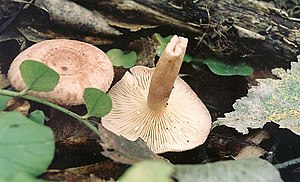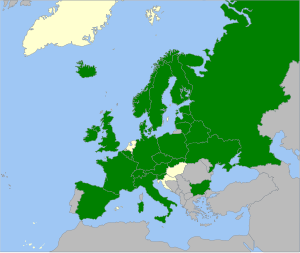Flaky milkling
| Flaky milkling | ||||||||||||
|---|---|---|---|---|---|---|---|---|---|---|---|---|

The scaly milkling ( Lactarius spinosulus ) |
||||||||||||
| Systematics | ||||||||||||
|
||||||||||||
| Scientific name | ||||||||||||
| Lactarius spinosulus | ||||||||||||
| Quél. |
The Schüppchen-Milchling or Pink Schüppchen-Milchling ( Lactarius spinosulus ) is a type of fungus from the family of the deaf relatives (Russulaceae). It is a rather small, slender, salmon-pink to brick-colored milkling with a finely-scaled, zoned hat that is hairy on the edge. The very rare, inedible mushroom often grows in grassy areas under birch trees, the fruiting bodies appear from August to October.
features
Macroscopic features
The hat is 2–6 (7) cm wide, initially flatly arched and often slightly hunched, then slightly depressed and bifurcated in the middle, later more and more depressed until it is funnel-shaped deepened. The edge of the hat is curved in young fruiting bodies. The surface of the pinkish-yellow-brown to wine-brown and sometimes slightly darker zoned hat is dry, tomentose to finely scaly and slightly greasy when moist. The hat is initially more or less smooth in the middle, but soon becomes increasingly flaky, with the pointed scales sticking out clearly towards the outside. The edge is often hairy with fine bristles and mostly clearly zoned, especially towards the outside.
The initially rather dense lamellae have grown broadly on the stem and run down easily. The rather thin, narrow lamellae, which are often forked near the stem, are cream-colored with a pink reflex when young and later turn pale reddish-ocher or cream-brownish. The spore powder is light to ocher yellow and has a slightly salmon-colored tint.
The cylindrical or slightly compressed stem is 2.5-5 cm long and 0.5-1.2 cm wide. The surface is smooth or slightly pitted and flesh-pink, salmon-colored to pale brownish-wine-red and often with white fibers. It is about the same color as the hat or a little paler. The inside of the stem is initially full and later stuffed until it is hollow.
The whitish to pale wine-reddish flesh is medium firm and tastes mild and, after some chewing, slightly bitter or pungent. It smells fruity like gooseberries or more like the oak milkling ( L. quietus ). The milk is white to watery white and tastes mild at first, then slowly bitter to pungent, especially at the end of the tongue.
Microscopic features
The rounded to elliptical spores are on average 6.8–7.8 µm long and 5.5–6.0 µm wide. The Q value (quotient of spore length and width) is 1.1–1.4. The spore ornament is 0.8–1.3 µm high and consists of long, sparsely branched ridges and a few isolated warts that are not or only sparsely connected in a network and together form a striking zebra-stripe pattern. The hillock is more or less inamyloid or irregularly amyloid.
The mostly 4-spore, 30–50 µm long and 8–12 µm wide basidia are more or less cylindrical to almost club-shaped. Pleuromacrocystidae are quite scattered. They are 40–65 (100) µm long and 6–10 (13) µm wide, awl-shaped, narrowly conical or spindle-shaped and more or less pointed at their upper end. The lamellar edges are heterogeneous. In addition to the basidia, there are quite a number of cheilomacrocystids which measure 30–55 × 5–7 µm and are more or less spindle-shaped or awl-shaped. They are pointed at the top or have a small pointed tip.
The hat skin ( Pileipellis ) is a cutis of parallel, partly tufted ascending, 2.5–6 (12) µm wide hyphae . In places it turns into a trichoderm . The hyphae walls are partially gelatinized.
Species delimitation
Two similar Milchling are the Lila Milchling ( L. lilacinus ) and the Birch-Reizker ( L. torminosus ), but both of them usually form much larger fruiting bodies. In spite of its similar colors, the Schüppchen Milchling differs from the Lila Milchling simply in that it occurs mainly under birch trees on drier soils, while the Lila Milchling, which has a more velvety and barely zoned hat, grows under willows.
The birch-irritant differs through its at least young bearded hairy hat rim. The two species can be easily differentiated microscopically, as both have clearly reticulated ornamented spores and their top layer is completely different.
ecology
The Schüppchen-Milchling is a mycorrhizal fungus that is associated with various types of birch. Its most important habitat are moist deciduous or mixed forests on fresh to moist, more or less nutrient-rich soils. It is particularly common at the edges of forests and not infrequently in parks. It is not tied to defined forest communities. Its fruiting bodies appear singly or gregariously from late August to late October, mainly in the hills and mountains.
distribution
The Milchling was found in North America (USA) and Europe. In Europe it is seldom to very scattered. It occurs in France and Great Britain and is common in northwestern Europe to the Hebrides and Iceland. In the Benelux countries it is very rare or completely absent, but it occurs throughout Central Europe. In Fennoscandinavia it is scattered to very rare.
The Milchling is rare to very rare in both Germany and Switzerland. Due to its rarity, the species is potentially endangered in Germany.
Systematics
The scaly milkling was first described in 1879 by L. Quélet as Lactarius spinosulus . In 1891 O. Kuntze placed the species in his work " Revisio generum plantarum " in the genus Lactifluus ; In 1908 the species was downgraded by the French poet and mycologist F. Bataille to the variety Lactarius lilacinus var. Spinosulus , which by Singer in 1942 to the subspecies Lactarius lilacinus subsp. spinosulus has been re-promoted.
There are also other taxonomic synonyms . Lactarius mitificus Britzelm. (1897), including its taxonomic synonyms: Lactarius lilacinus var. Mitificus (Britzelm.) Killerm. (1933) and Lactarius lilacinus subsp. mitificus (Britzelm.) Singer (1942). Also in Lactarius lilacinus var. Minor Killerm. and the Lactarius lilacinus in the sense of JELange are synonyms.
The species attribute ( epithet ) "spinosulus" means somewhat thorny and refers to the bristly hair-like scales on the edge of the hat.
Inquiry systematics
The Schüppchen Milchling was placed in the Colorati section by Bon , although the other species in the section have a whitish spore powder and blunt macrocystidia, and its spore ornamentation is also significantly less reticent. It was probably placed in this section because of its superficial resemblance to the purple milkling ( L. lilacinus ). Basso and Heilmann-Clausen, on the other hand, place the Milchling near the brown-shaggy Milchling ( L. mairei ) in the section and subsection Piperites , since it seems to be very similar to this species both microscopically and due to its macroscopic features.
meaning
The rare Milchling is not an edible mushroom.
literature
- Jacob Heilmann-Clausen among others: The genus Lactarius . Ed .: The Danish Mycological Society (= Fungi of Northern Europe . Volume 2 ). 1998, ISBN 87-983581-4-6 (English).
- Marcel Bon (ed.): Parey's book of mushrooms . Franckh-Kosmos Verlag, Stuttgart 2005, ISBN 3-440-09970-9 , pp. 88 .
Web links
- Synonyms of Lactarius spinosulus. In: speciesfungorum.org. Index Fungorum, accessed June 20, 2011 .
- Lactarius spinosulus. In: Russulales News / mtsn.tn.it. Archived from the original on September 10, 2004 ; accessed on June 20, 2011 (English, photos and brief description).
- Lactarius spinosulus. In: Funghi in Italia / funghiitaliani.it. Retrieved on March 2, 2012 (Italian, good photos of the Schüppchen-Milchling).
Individual evidence
- ↑ a b c d e Jacob Heilmann-Clausen and others: The genus Lactarius . Ed .: The Danish Mycological Society (= Fungi of Northern Europe . Volume 2 ). 1998, p. 166-167 .
- ↑ a b c d Josef Breitenbach, Fred Kränzlin (Ed.): Pilze der Schweiz. Contribution to knowledge of the fungal flora in Switzerland. Volume 6: Russulaceae. Milklings, deafblings. Mykologia, Luzern 2005, ISBN 3-85604-060-9 , p. 108.
- ↑ Roger Phillips: Lactarius spinosulus. (No longer available online.) In: rogersmushrooms.com. RogersMushrooms website, archived from the original on March 4, 2016 ; accessed on June 20, 2011 (English). Info: The archive link was inserted automatically and has not yet been checked. Please check the original and archive link according to the instructions and then remove this notice.
- ↑ a b German Josef Krieglsteiner (ed.), Andreas Gminder , Wulfard Winterhoff: Die Großpilze Baden-Württemberg . Volume 2: Stand mushrooms: inguinal, club, coral and stubble mushrooms, belly mushrooms, boletus and deaf mushrooms. Ulmer, Stuttgart 2000, ISBN 3-8001-3531-0 , p. 425.
- ↑ Worldwide distribution of Lactarius spinosulus. (No longer available online.) In: GBIF Portal / data.gbif.org. Archived from the original on March 4, 2016 ; Retrieved September 14, 2011 . Info: The archive link was inserted automatically and has not yet been checked. Please check the original and archive link according to the instructions and then remove this notice.
- ↑ Jacob Heilmann-Clausen among others: The genus Lactarius . Ed .: The Danish Mycological Society (= Fungi of Northern Europe . Volume 2 ). 1998, p. 271-73 .
- ↑ Cvetomir M. Denchev, Boris Assyov: Checklist of the macromycetes of Central Balkan Mountain (Bulgaria) . In: Mycotaxon . tape 111 , 2010, p. 279–282 ( mycotaxon.com [PDF; 578 kB ]).
- ↑ Interactive map of Lactarius spinosulus. (No longer available online.) In: NBN Gateway / data.nbn.org.uk. Archived from the original on December 24, 2012 ; accessed on March 4, 2012 (English). Info: The archive link was inserted automatically and has not yet been checked. Please check the original and archive link according to the instructions and then remove this notice.
- ↑ Otto Kuntze: Revisio generum plantarum . secundum leges nomenclaturae internationales cum enumeratione plantarum exoticarum. Part 2. Leipzig / London / Paris 1891, p. 857 ( gallica.bnf.fr ).
- ^ Frédéric Bataille : Flore Monographique des Astérosporées, Lactaires et Russules . tape 1 . F. Bataille, Besançon 1908, p. 37 (French, cyberliber ).
- ↑ Max Britzelmayr: Materials to describe the Hymenomycetes . Critical studies, especially on M. Britzelmayr; Location information and (short) determination tables. In: Memoranda of the Bayer. Botanical Society in Regensburg . tape 71 . Gotthelft Brothers, royal court book printer, 1897, p. 55 ( bibdigital.rjb.csic.es ).
- ↑ Sebastian Killermann: Mushrooms from Bavaria . Critical studies, especially on M. Britzelmayr; Location information and (short) determination tables. In: Memoranda of the Bayer. Botanical Society in Regensburg . tape 19 , 1933, pp. 84 ( bvbm1.bib-bvb.de ).
- ↑ Rolf Singer: The system of the Agaricales. II . In: Annales Mycologici . tape 40 , no. 1-2 , 1942, pp. 125 ( cybertruffle.org.uk ).
- ↑ Jakob Emanuel Lange: Flora agaricina Danica. tape V . Recato, Copenhagen 1940, p. 43 (English, gallica.bnf.fr ).
- ^ Karl Ernst Georges: Spinosulus . Detailed concise Latin-German dictionary. tape 1 . Hanover 1913, Sp. 2762 ( zeno.org ).
- ^ Maria Teresa Basso: Lactarius Persoon (= Fungi Europaei . Volume 7 ). 1999, ISBN 88-87740-00-3 , pp. 48-63, 391 (Italian).
